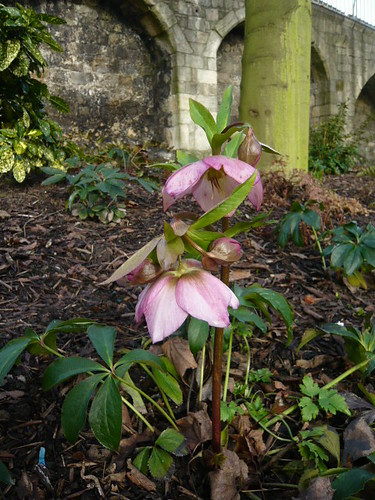Gardening with Hellebores
Hellebores are generally very accommodating plants flowering early in spring and living happily in shade. Avoid Helleborus foetidus the stinking hellebore or setterwort, if you want coloured rose like flowers but it has shapely green florescence if you like growing a flower green bed.

As this graphic shows there are a growing number of hybrids offering a range of colours.
See our tips on Growing Helebores

Helleborus orientalis in the Woodland Garden at Kew, spring 2011.
First Hellebore of the Year
My own Hellebores are still under several inches of snow but this pink Hellebore was flowering happily in a sheltered garden in York on th 3rd February. Called the ‘Secret Garden’ near St Cuthbert’s church, Peasholme Green, it is situated under the shelter of the walls that surround most of York.
Hellebores are easy to grow and are more collectible since good hybrids have come on the market. Our more comprehensive list of various species is available here. They are tolerant of most soil conditions but prefer moist soil although they can stand drought.
The Stinking Hellebore foetidus is a compact, evergreen perennial with finely divided elegant foliage. Height up to 2 feet with a similar spread. The scent leaves a lot to be desired. In spring the almost ferny clumps have clusters of nodding, lime-green, long lasting flowers held on thick stems just above the tops of the foliage. These Hellebores associate well with other spring flowers that enjoy dappled shade such as primroses. Again in 2010 they seem to be in flower earlier than usual.
Hellebore Hell may smell like this!
Stinking Hellebore gets its name from the unpleasant scent it emits, which is more noticeable if you pinch the glossy, serrated leaves. The plant produces the scent to attract insects for pollination early in the year when there are fewer insects around. Honey made from this Hellebore can be toxic.
The cultivar ‘Green Giant’ has very bright green flowers and finely divided foliage, ‘Miss Jekyll’ has scented flowers whose intensity varys with the time of day; ‘Wester Flisk Group’ has red-tinted leaves and succulent stems and gray-green flowers. They seed quite easily but take 3-4 years to grow to a good size. Mamie Walker is the person who first discovered the red-stemmed form growing in her garden at Wester Flisk, near Newburgh in Fife noticing that the flowers had a better red edge in dry seasons. More photographs can be seen on a Spanish website topwalks.
Hayloft plants is selling 5 plants in the Lady series, Red Lady, Yellow Lady, Pink Lady, White spotted Lady, and Blue Metallic Lady.
For some great double flowered Hellebores available from Thompson & Morgan
Species from Wikipedia
Helleborus niger – Christmas rose or black hellebore
Helleborus orientalis – Lenten rose, Lenten hellebore, oriental hellebore (N.B. most of the Lenten hellebores in gardens are now considered to be H. × hybridus)
Helleborus argutifolius – Corsican hellebore
Helleborus lividus
Helleborus vesicarius
Helleborus atrorubens
Helleborus croaticus
Helleborus cyclophyllus
Helleborus dumetorum
Helleborus abruzzicus
Helleborus liguricus
Helleborus boconei
Helleborus multifidus
Helleborus multifidus subsp. hercegovinus
Helleborus multifidus subsp. istriacus
Helleborus multifidus subsp. multifidus
Helleborus niger subsp. macranthus (syn. H. niger major)
Helleborus niger subsp. niger
Helleborus odorus
Helleborus odorus subsp. laxus
Helleborus odorus subsp. odorus
Helleborus orientalis subsp. abchasicus (syn. H. abchasicus)
Helleborus orientalis subsp. guttatus
Helleborus orientalis subsp. orientalis (syn. H. caucasicus, H. kochii)
Helleborus purpurascens
Helleborus thibetanus (syn. H. chinensis)
Helleborus torquatus
Helleborus viridis – green hellebore or bear’s-foot
Helleborus occidentalis (formerly H. viridis subsp. occidentalis)
Other species names (now considered invalid) may be encountered in older literature, including H. hyemalis, H. polychromus, H. ranunculinus, H. trifolius.
Credit
Helleborus orientalis by Kew CC BY-NC-SA 2.0



7 thoughts on “Gardening with Hellebores”
A great plant, which offers good value when garden is often at its barest.
Comments are closed.